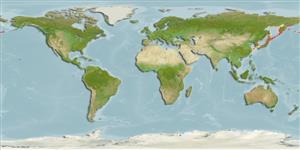>
Perciformes/Cottoidei (Sculpins) >
Cyclopteridae (Lumpfishes) > Eumicrotreminae
Etymology: Cyclopteropsis: Greek, kyklos = round + Greek, pteron = fin + Greek, opsis = similar to, shape (Ref. 45335).
Eponymy: Dr Georgii Ustinovich Lindberg (1894–1976) was a Russian ichthyologist and marine biologist who was a lecturer at Chita University and who was invited (1923) to the Far-Eastern University in Vladivostok where he established a coastal biological [...] (Ref. 128868), visit book page.
Environment: milieu / climate zone / depth range / distribution range
Ecología
marino demersal; rango de profundidad 20 - 200 m (Ref. 56557). Temperate
Northwest Pacific: Bering Sea to southeastern Kamchatka, the Sea of Okhotsk, and Japan Sea to Korean Peninsula.
Tamaño / Peso / Age
Maturity: Lm ? range ? - ? cm
Max length : 7.0 cm TL macho / no sexado; (Ref. 56557)
Life cycle and mating behavior
Madurez | Reproducción | Puesta | Huevos | Fecundidad | Larva
Masuda, H., K. Amaoka, C. Araga, T. Uyeno and T. Yoshino, 1984. The fishes of the Japanese Archipelago. Vol. 1. Tokai University Press, Tokyo, Japan. 437 p. (text). (Ref. 559)
IUCN Red List Status (Ref. 130435: Version 2024-1)
Threat to humans
Harmless
Human uses
Herramientas
Special reports
Download XML
Fuentes de Internet
Estimates based on models
Preferred temperature (Ref.
123201): 0.6 - 15.3, mean 2.7 °C (based on 78 cells).
Phylogenetic diversity index (Ref.
82804): PD
50 = 0.5078 [Uniqueness, from 0.5 = low to 2.0 = high].
Bayesian length-weight: a=0.02089 (0.00774 - 0.05639), b=3.03 (2.80 - 3.26), in cm total length, based on LWR estimates for this (Sub)family-body shape (Ref.
93245).
Nivel trófico (Ref.
69278): 3.2 ±0.4 se; based on size and trophs of closest relatives
Resiliencia (Ref.
120179): Alto, población duplicada en un tiempo mínimo inferior a 15 meses (Preliminary K or Fecundity.).
Fishing Vulnerability (Ref.
59153): Low vulnerability (10 of 100).
